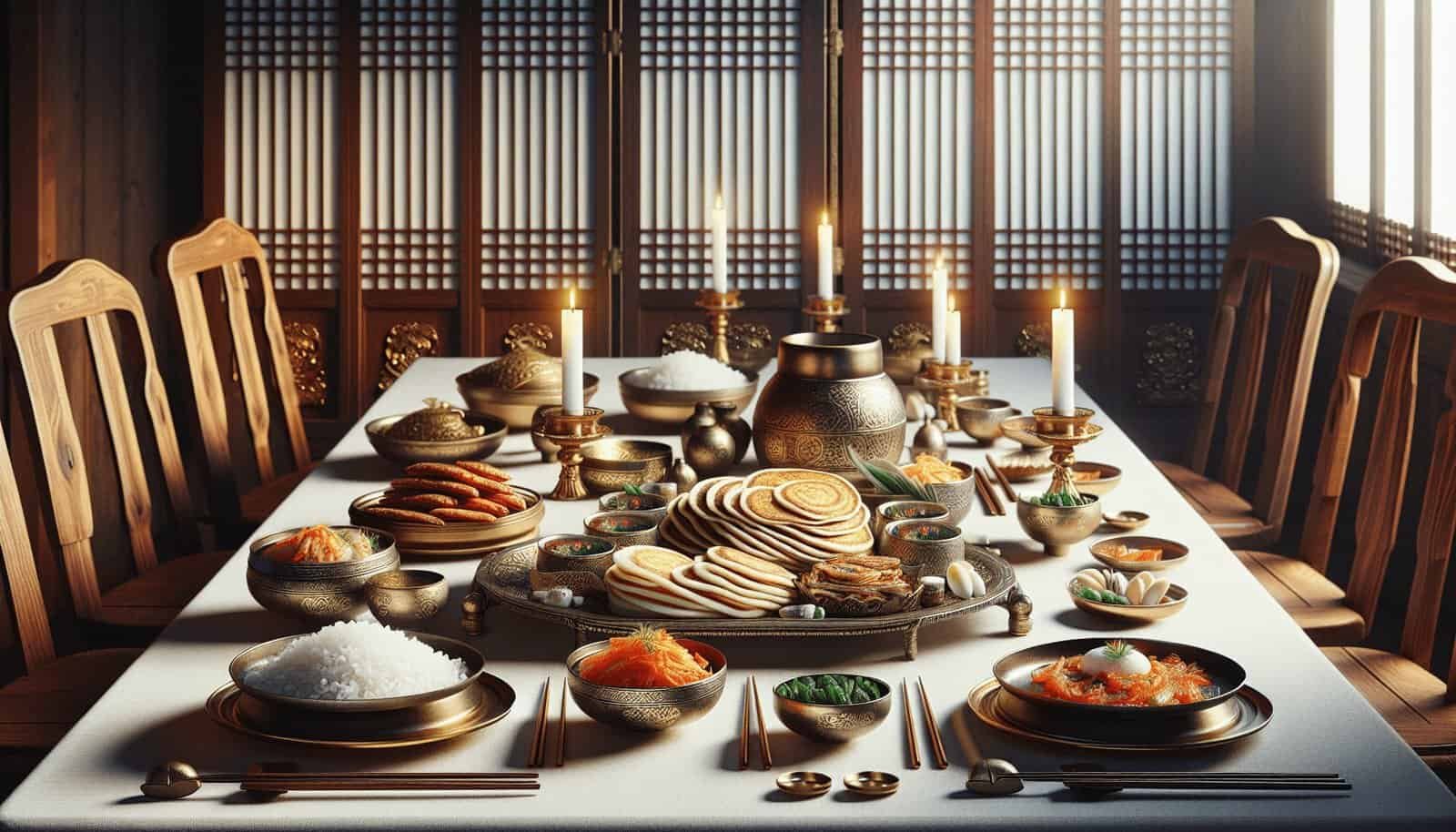In the article “Can You Recommend Traditional Korean Dishes That Are Associated With Ancestral Rituals?” you are invited to explore the rich tapestry of Korean culinary heritage that is deeply intertwined with time-honored traditions. You’ll discover a variety of dishes that not only tantalize your taste buds but also serve as a bridge connecting you to Korean ancestral rituals. From the delicately prepared jeon (savory pancakes) to the richly infused flavors of japchae (stir-fried glass noodles), each dish has its unique place and meaning in these sacred ceremonies. These recipes are more than just food; they are a reflection of cultural reverence and familial love passed down through generations. Have you ever wondered about the fascinating world of traditional Korean cuisine, specifically those dishes tied to ancestral rituals? If so, you’re in for a treat. Let’s take a flavorful journey through some of the traditional dishes deeply connected to Korean ancestral rites. These dishes not only offer a unique taste but also carry a rich cultural significance, rooted in centuries of history and tradition.
What Are Korean Ancestral Rituals?
Korean ancestral rituals, known as “Jesa” or “Gosa”, are ceremonies that honor deceased ancestors and involve presenting offerings, including specially prepared foods. These rituals play a significant role in Korean culture, reflecting deep respects for one’s heritage and ancestors. The culinary aspect of these rituals involves preparing and presenting various traditional dishes that are believed to nourish the spirits of the ancestors.
Different Types of Ancestral Rituals
There are several types of ancestral rituals in Korea, each with its own unique customs and dishes. Here’s a brief overview:
Jesa (제사): This is a general term for ancestral rites, performed on different occasions such as death anniversaries (Gijesa) or holidays (Seongmyo or Chuseok).
Charye (차례): These are ancestral rituals conducted during major holidays like the Lunar New Year (Seollal) and Harvest Festival (Chuseok).
Gosa (고사): Often performed to bring good fortune and prevent misfortune, Gosa ceremonies involve offerings and prayers, typically for new ventures like moving into a new home or starting a new business.
The Significance of Food in Ancestral Rites
Food is a central element in every Korean ancestral ritual. It’s not just about preparing a meal; it’s about creating a meaningful and respectful connection between the living and their ancestors. Each dish has a symbolic meaning, representing elements like prosperity, health, and happiness.
Key Components of Ancestral Ritual Foods
When it comes to preparing foods for Jesa, there are certain rules and guidelines. Here are some key components:
Variety and Balance: A typical ancestral rites table will have a variety of dishes to symbolize the abundance and quality of life the ancestors are hoped to enjoy in their afterlife. A balanced table traditionally includes grains, meat, fish, vegetables, fruits, and rice cakes.
Presentation: How the food is presented is crucial. Dishes are placed in a specific order, usually aligning with the Confucian principles.
Purity: Ingredients should be as fresh and natural as possible. Avoiding artificial seasonings and additives is important to maintain the dish’s purity.

Traditional Dishes Associated with Korean Ancestral Rituals
Now, let’s delve into some traditional Korean dishes that are prominently featured in ancestral rituals. Each of these dishes has been chosen for its symbolic value and historical significance.
Japchae (잡채)
Japchae, a savory and slightly sweet dish made from stir-fried glass noodles, vegetables, and sometimes meat, holds a significant spot in Jesa ceremonies. It symbolizes harmony and unity, akin to the blending of different ingredients to create a unified dish.
Ingredients:
- Sweet potato noodles (glass noodles)
- Spinach
- Carrots
- Onion
- Mushrooms
- Beef or pork (optional)
- Soy sauce
- Sesame oil
- Sugar
- Garlic
Japchae is known for its delightful texture and the perfect balance of flavors, making it a beloved dish in many Korean households, especially during celebratory times.
Jeon (전)
Jeon refers to a variety of Korean pancakes made with a range of ingredients, such as vegetables, seafood, and meat. It’s often served during Jesa rituals because it represents good health and longevity.
Types of Jeon:
- Donggeurangttaeng (동그랑땡): Small, round meat patties.
- Yachaejeon (야채전): Vegetable pancakes.
- Haemul Pajeon (해물파전): Seafood and green onion pancakes.
Jeon is easy to make and customizable, allowing families to use whatever ingredients they have on hand, making it a versatile part of the ritual meal.
Tteok (떡)
Rice cakes, known as Tteok, are indispensable in Korean rituals. These cakes symbolize purity and longevity. There are several varieties, including:
- Baekseolgi (백설기): Steamed white rice cakes that symbolize cleanliness and purity.
- Yakgwa (약과): Honey cookies, often used to symbolize health and sweetness in life.
Each type of Tteok carries a special meaning, making it a profound offering during ceremonial practices.
Galbijjim (갈비찜)
Galbijjim, or braised short ribs, is another significant dish in ancestral rituals. This rich, meaty dish represents longevity and strength, which are highly valued in Korean culture.
Ingredients:
- Beef short ribs
- Soy sauce
- Garlic
- Ginger
- Sesame oil
- Sugar
- Carrots
- Radishes
- Shiitake mushrooms
Galbijjim is known for its tender meat and flavorful broth, making it a comforting and hearty dish that’s perfect for special occasions.
Sinseollo (신선로)
Sinseollo, a type of Korean hotpot with an assortment of meat, fish, and vegetables, is often served during more elaborate ceremonies. It symbolizes harmony and balance, offering sustenance to nourish the spirits.
Ingredients:
- Beef
- Chicken
- Fish
- Vegetables (carrots, mushrooms, spinach)
- Pine nuts
- Broth made from beef bones or anchovies
The preparation of Sinseollo is intricate, reflecting the care and respect given to ancestral rituals.
Bindaetteok (빈대떡)
Bindaetteok, also known as mung bean pancakes, are often included in the Jesa table. They represent abundance and prosperity.
Ingredients:
- Mung beans
- Napa cabbage
- Green onions
- Kimchi
- Pork (optional)
- Salt
Bindaetteok is crunchy on the outside and soft on the inside, offering a unique texture that pairs well with other ritual dishes.
Fruits and Nuts
Fruits and nuts play a symbolic role in ancestral rituals. They are selected for their auspicious meanings and placed meticulously on the rites table.
Common Selections:
- Jujube (대추): Symbolizes fertility and prosperity.
- Chestnuts (밤): Represents strong offspring.
- Persimmons (감): Symbolizes transformation and change.
- Pomegranates (석류): Signifies many descendants.
Placing these fruits and nuts on the ritual table shows a hope for the family’s continued prosperity and well-being.
Preparing a Jesa Table
Setting up the Jesa table is an art in itself. Each dish has its place, and its positioning is thought to invite the spirits harmoniously.
Step-by-Step Guide
- Table Layout: Traditionally, tables are long and narrow, with a distinct orientation. The northern side represents the back, where the ancestral memorial tablet is placed.
- East-West Order: Certain foods like rice and soups are placed on the eastern side, while wine and side dishes are arranged on the western side.
- Central Placement: Main dishes such as meat and fish are centered, showing their importance.
The meticulous arrangement of the dishes is a form of respect and expression of ancestral reverence.
Example Table
Here’s a simplified example of how a Jesa table might look:
| East | Center | West |
|---|---|---|
| Steamed Rice (밥) | Galbijjim (Braised Short Ribs) | Wine (술) |
| Soybean Paste Soup | Various Jeon (Pancakes) | Kimchi (김치) |
| Various Vegetables | Sinseollo (Hotpot) | Fruits and Nuts |
| Tteok (Rice Cake) | Japchae (Glass Noodles) |
Each element on this table is chosen with care and precision, embodying respect and tradition.

Customary Practices
While preparing and presenting the food is crucial, there are also several customary practices associated with the rituals themselves:
- Prayers and Bowing: Family members bow multiple times to honor their ancestors.
- Offering Foods and Drinks: Portions of each dish are offered to the spirits first before the living members consume it.
These practices are carried out with solemn respect, ensuring that the ritual remains a meaningful family tradition.
Variations in Ritual Foods
The foods used in Jesa can vary by region and family tradition. For example, what might be common in Seoul could be different from what’s traditional in the Jeju Province.
Regional Differences
- Seoul: Emphasis is placed on Galbijjim, various Jeon, and multiple side dishes.
- Jeolla Province: Lighter dishes like vegetable-based Jeon and Namul (seasoned vegetable dishes) are more common.
- Gyeongsang Province: Spicier dishes might find their way into the Jesa table, reflecting local tastes.
Family-Specific Traditions
Each family often has unique dishes passed down through generations, serving as a way to preserve their specific heritage and culinary practices.

Modern Adaptations
In today’s fast-paced world, some families adapt traditional dishes to suit contemporary lifestyles while retaining their symbolic importance. This might include:
- Simplified Preparations: Using pre-made sauces or shortcuts to save time while keeping the dish’s integrity.
- Healthy Alternatives: Substituting ingredients for healthier options without losing the traditional taste.
Adapting these dishes allows for continued practice of ancestral rituals in a way that fits modern living.
Tips for Preparing Ancestral Ritual Dishes
If you decide to delve into making these traditional dishes, here are some tips to help you get started:
- Fresh Ingredients: Always opt for the freshest ingredients to ensure the best flavor and authenticity.
- Balanced Flavors: Korean culinary traditions emphasize a balance of flavors. Make sure to balance sweet, salty, sour, and umami aspects in your dishes.
- Respect Tradition: While adaptations are okay, try to maintain the core elements and presentation that honor the traditions.
These tips can help you prepare dishes that are not only delicious but also culturally significant.

Conclusion
Traditional Korean dishes associated with ancestral rituals are much more than just food; they are symbols of respect, heritage, and family values. By preparing and sharing these dishes, you participate in a rich cultural tradition that honors the past while nurturing the present. Whether you’re making Galbijjim, Japchae, or Jeon, remember that each dish carried centuries of history and significance.
So, the next time you find yourself wondering about Korean ancestral rituals and the foods that accompany them, you’ll have a deeper understanding and appreciation for this fascinating aspect of Korean culture. Enjoy your culinary journey, and don’t forget to share your experiences with loved ones.
